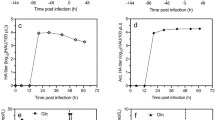Abstract
Biopolymer membrane was prepared using two oppositely charged natural biopolymer. The biopolymer membrane was used for the encapsulation of two hybridoma cell (ATCC CRL-1606, ATCC BH-8852) to produce monoclonal antibodies. In order to reduce the down stream steps, the pore size of the membrane was controlled to retain the monoclonal antibodies in the capsules based on the diffusion experiments with standard proteins. T-flask culture showed cell densities of 8×107 cells/mL and 3×107 cells/mL, and MAb concentrations of 506 μg/mL and 109 μg/mL for encapsulated ATCC CRL-1606 and HB-8852, respectively. Two liter perfusion culture with encapsulated ATCC HB-8852 was performed to enhance the MAb production. The MAb production of the encapsulated hybridoma increased considerably comparing to the culture using silicone tubing for oxygen transfer.
Access this article
We’re sorry, something doesn't seem to be working properly.
Please try refreshing the page. If that doesn't work, please contact support so we can address the problem.
Similar content being viewed by others
References
Kim, S. K. (1994) Cell immobilization using encapsulation technique and its applications,Biotechnology News 1(3): 28–32.
Rha, C. K. and D. Rodriguez-Sanchez (1988) Process for Encapsulation and Encapsulated Active Material System,US patent, 4, 774, 937.
Lee, J. S. and S. K. Kim (1996) Preparation and Applications of Synthetic Fish Capsules from Marine Polysaccharides,Korean Journal of Life Science 6(1): 34–39.
Yu, S. H., J. H. Son, and S. K. Kim (1997) The Growth of Encapsulated Human Hepatoma,Korean J. Biotechnol. Bong. 12(4): 413–416.
Kim, S. K. and C. K. Rha (1989) Transmembrane Permeation of Protein in Chitosan Capsules,Chitin and Chitosan-Sources, Chemistry, Biochemistry, Physical Properties and Applications, (Skjak-Braek, G., Anthonsen, T., andSandford, P., Elsevier Science Pub., New York), 636–642
Kim, S. K. and C. K. Rha (1989) Chitosan for the Encapsulation of Mammalian Cell Culture,Chitin and Chitosan-Sources, Chemistry, Biochemistry, Physical Properties and Applications, (Skjak-Braek, G., Anthonsen, T., andSandford, P., Elsevier Science Pub., New York), 644–652.
Gupta, S., S. K. Kim, R. P. Vemure, E. Aragona, P. R. Yerneni, R. D. Burk, and C. K. Rha (1993) Hepatocyte transplantation:an alternative system for evaluating cell survival and immunoisolation.The International Journal of Artificial Organs, 16(3): 155–163.
Fleischaker, R. J., Jr. and A. Sinskey (1981) Determination of O2 transfer rate using silicone tubing in cell culture,Eur. J. Appl. microbiol Biotechnol. 12: 193–197.
Author information
Authors and Affiliations
Corresponding author
Rights and permissions
About this article
Cite this article
Kim, SK., Son, JH. & Yu, SH. Encapsulated animal cell culture for the production of monoclonal antibody (MAb). Biotechnol. Bioprocess Eng. 2, 73–76 (1997). https://doi.org/10.1007/BF02932327
Issue Date:
DOI: https://doi.org/10.1007/BF02932327



